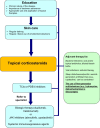Atopic dermatitis
- PMID: 39654051
- PMCID: PMC11629513
- DOI: 10.1186/s13223-024-00927-2
Atopic dermatitis
Abstract
Atopic dermatitis (AD) is a common, chronic skin disorder that can significantly impact the quality of life (QoL) of affected individuals as well as their families. Although the pathogenesis of the disorder is not yet completely understood, it appears to result from the complex interplay between defects in skin barrier function, environmental and infectious agents, and immune dysregulation. There are no diagnostic tests for AD; therefore, the diagnosis is based on specific clinical criteria that take into account the patient's history and clinical manifestations. Successful management of the disorder requires a multifaceted approach that involves education, optimal skin care practices, anti-inflammatory treatment with topical corticosteroids, topical calcineurin inhibitors (TCIs) and/or phosphodiesterase-4 (PDE-4) inhibitors, the management of pruritus, and the treatment of skin infections. Systemic immunosuppressive agents may also be used, but are generally reserved for severe flare-ups or more difficult-to-control disease. Newer systemic agents, such as Janus Kinase (JAK) inhibitors and biologics, have a more favourable safety and efficacy profile than the older, traditional systemic immunosuppressives. Topical corticosteroids are the first-line pharmacologic treatments for AD, and evidence suggests that these agents may also be beneficial for the prophylaxis of disease flare-ups. Although the prognosis for patients with AD is generally favourable, those patients with severe, widespread disease and concomitant atopic conditions, such as asthma and allergic rhinitis, are likely to experience poorer outcomes. Newer systemic agents have been approved which are greatly improving the QoL of these patients.
Keywords: Atopic dermatitis; Biologics; Diagnosis and management; Emollients; JAK inhibitors; Phosphodiesterase-4 inhibitors; Skin care practices; Topical calcineurin inhibitors; Topical corticosteroids.
© 2024. The Author(s).
Conflict of interest statement
Declarations. Ethics approval and consent to participate: Ethics approval and consent to participate are not applicable to this review article. Consent for publication: Not applicable. Competing interests: Dr. Stuart Carr has participated in speaker’s bureaus and advisory boards with Sanofi. Dr. Rebecca Pratt has received consulting fees and honoraria for continuing education sessions from Merck, Medexus, Novartis, Astrazenca, GSK, Sanofi, Covis, Aralez, Stallergens-Greer, Bausch, AbbVie and ALK. Dr. Fred White: none. Dr. Wade Watson is medical advisor for Food Allergy Canada. None of the authors received any incentive or funding for the preparation or review of the manuscript. About this supplement: This article has been published as part of Allergy, Asthma & Clinical Immunology, Volume 20 Supplement 03, 2024: Practical Guide for Allergy and Immunology in Canada 2024. The full contents of the supplement are available at https://aacijournal.biomedcentral.com/articles/supplements/volume-20-supplement-3 .
Figures
References
-
- Krakowski AC, Eichenfield LF, Dohil MA. Management of atopic dermatitis in the pediatric population. Pediatrics. 2008;122:812–24. - PubMed
-
- McKenna SP, Doward LC. Quality of life of children with atopic dermatitis and their families. Curr Opin Allergy Clin Immunol. 2008;8:228–31. - PubMed
-
- Gonzalez-Uribe V, Vidaurri-de la Cruz H, Gomez-Nuñez A, Leyva-Calderon JA, Mojica-Gonzalez ZS. Comorbidities & burden of disease in atopic dermatitis. Asian Pac J Allergy Immunol. 2023;41(2):97–105. - PubMed
-
- Barbeau M, Bpharm HL. Burden of atopic dermatitis in Canada. Int J Dermatol. 2006;45(1):31–6. - PubMed
Publication types
LinkOut - more resources
Full Text Sources





